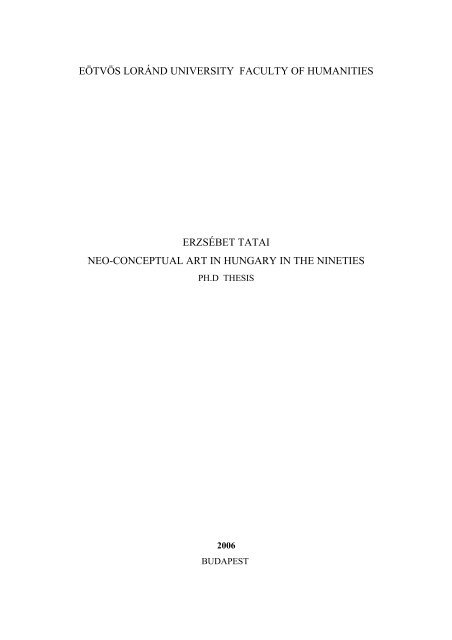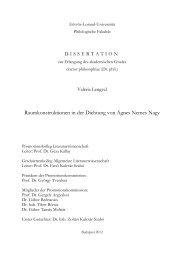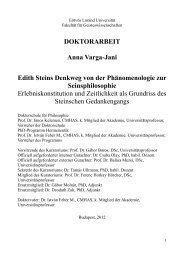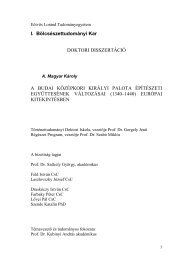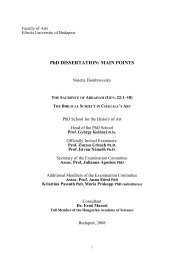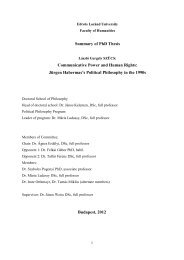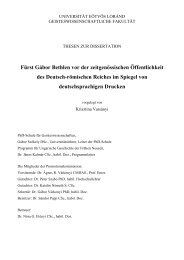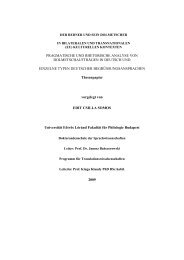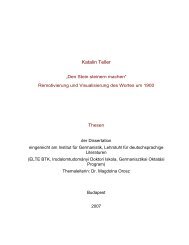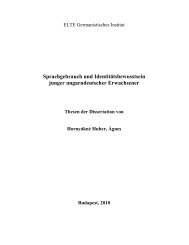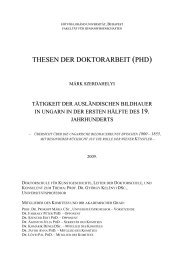eötvös loránd university faculty of humanities - ELTE BTK disszertációk
eötvös loránd university faculty of humanities - ELTE BTK disszertációk
eötvös loránd university faculty of humanities - ELTE BTK disszertációk
Create successful ePaper yourself
Turn your PDF publications into a flip-book with our unique Google optimized e-Paper software.
EÖTVÖS LORÁND UNIVERSITY FACULTY OF HUMANITIES<br />
ERZSÉBET TATAI<br />
NEO-CONCEPTUAL ART IN HUNGARY IN THE NINETIES<br />
PH.D THESIS<br />
2006<br />
BUDAPEST
The aims <strong>of</strong> research. The theme <strong>of</strong> the thesis<br />
Emerging in the 1960s, Conceptual Art was a movement that seemed to accomplish<br />
Modernism; however, with its institution-critique and political content it contributed to the<br />
deconstruction <strong>of</strong> the modernist paradigm. Back in the late Sixties and early Seventies it was<br />
unforeseeable that anti-formalist, issue-based Conceptual Art would herald Postmodernism. It<br />
seemed to accomplish Modernist art with the same explicit intellectualism that at the same<br />
time invoked the critical voice. The point is not only that contemporary art owes a lot to<br />
Conceptual Art, but also that its latest version is still a contemporary, vigorous phenomenon.<br />
Conceptual Art fundamentally changed the subsequent development <strong>of</strong> art, and this effect<br />
(influencing not only artistic but also the art-historic practice) became evident by the Nineties.<br />
The renewed interest in Conceptual Art internationally coincided with the political turn in<br />
Hungary. There is no obvious direct influence <strong>of</strong> Western art on Hungarian art; however, the<br />
reappearance <strong>of</strong> Conceptual Art in the Nineties in Hungary is related not only with the<br />
economic and political changes, but also with the movements <strong>of</strong> international art.<br />
In view <strong>of</strong> the fact that the Conceptual Art <strong>of</strong> the Nineties—in spite <strong>of</strong> a great many essential<br />
similarities—in many respects differs from its Sixties’ and Seventies’ antecedent, it is<br />
expedient to introduce distinguishing terminology. Accordingly, I find it important to<br />
establish conceptual-art terminology in accordance with the literary sources and art practices,<br />
as well as the periodization <strong>of</strong> Conceptual Art.<br />
In the course <strong>of</strong> my research I came to the conclusion that the Conceptual Art <strong>of</strong> the Nineties<br />
—in Hungary at least—forms a distinct period <strong>of</strong> Conceptual Art. My paper is concerned with<br />
mapping that distinct tendency <strong>of</strong> the Nineties which changed the face <strong>of</strong> Hungarian art in<br />
general in as much as it introduced issues such as identity, political and social questions and<br />
institution-critique.<br />
In addition to the exploration <strong>of</strong> the theoretical background and interrelationships, my aim<br />
was to establish—through case studies—a usable system <strong>of</strong> categories. The analysed<br />
Hungarian artworks are not local emulations <strong>of</strong> international clichés; nevertheless, similarities<br />
<strong>of</strong> strategies and modernness (conceivably) makes them part <strong>of</strong> the international discourse <strong>of</strong><br />
contemporary art.<br />
2
Tasks and research methods<br />
The survey <strong>of</strong> Hungarian Neo-Conceptual Art requires a short review <strong>of</strong> Conceptual Art and<br />
outline <strong>of</strong> relevant extrinsic and intrinsic theories. Because Hungarian art is inseparable both<br />
from the international trends and the socio-cultural changes in Hungary, I seek to analyse—<br />
within the limits <strong>of</strong> this paper—the “preliminaries,” i.e. the theories <strong>of</strong> both Conceptual Art<br />
and Hungarian art in the Nineties in the context <strong>of</strong> international art, and to position them in<br />
the Hungarian social frame <strong>of</strong> reference.<br />
Outlining the subject <strong>of</strong> research—establishing the co-ordinates <strong>of</strong> space and time—raises the<br />
methodological question <strong>of</strong> isolating it from parallel art phenomena—partly still-prevailing<br />
“classical” Conceptual Art and partly other contemporary art practices. The Nineties’ works<br />
<strong>of</strong> Conceptual Art created in the paradigm <strong>of</strong> classical Conceptual Art are set apart from Neo-<br />
Conceptual Art in that they do not contribute to the current contemporary discourse even<br />
when using the most up-to-date techniques and spectacular elements.<br />
Neo-Conceptual Art withstands the usual approaches for the reason that it can only be<br />
interpreted along lines <strong>of</strong> content, and not form or genre. Theoretically, a work <strong>of</strong> any type<br />
and genre can be Neo-Conceptual—an installation or painting even—provided it<br />
problematises current artistic or social issues. However, for methodological considerations I<br />
have kept to a “golden mean” and accordingly avoided borderline works.<br />
In the course <strong>of</strong> collecting, classifying and interpreting this material, I occasionally applied<br />
the method <strong>of</strong> comparative analyses in order to highlight the relationships between the<br />
conceptual works <strong>of</strong> different periods and areas.<br />
Structure <strong>of</strong> the thesis and the results <strong>of</strong> the research<br />
Conceptual art divides the art scene in regards <strong>of</strong> what is considered as real Conceptual Art,<br />
when and where it emerged, how long it lasted, whether it is over at all, and who the most<br />
important representatives are. However, irrespective <strong>of</strong> attitude—i.e. whether one is highly<br />
restrictive with regard to Conceptual Art (the artists, the place and time <strong>of</strong> their activity), or<br />
on the contrary, extends its domain—there is wide consensus about the significance <strong>of</strong><br />
Conceptual Art. One extreme opinions speaks about Conceptual Art as merely exerting an<br />
influence; while the other extreme considers it as very much alive. The common denominator<br />
<strong>of</strong> the many approaches is that the idea or concept is regarded as being <strong>of</strong> primary and crucial<br />
importance in a work <strong>of</strong> art, and execution secondary.<br />
3
However, the appreciation <strong>of</strong> the object <strong>of</strong> art and its role has changed significantly over the<br />
past decades: the negation <strong>of</strong> form and “objectness” has been replaced by the<br />
acknowledgement <strong>of</strong> the importance <strong>of</strong> execution. Works emerged whose perfect execution,<br />
too, seeks to serve the “conveyance <strong>of</strong> content.” In other words, Conceptual Art does not in<br />
every instance reject form; rather, it is opposed only to the “form-content” elaborated in the<br />
history <strong>of</strong> modern art.<br />
In the first part <strong>of</strong> my thesis I deal with the issues <strong>of</strong> terminology and periodisation. In the<br />
course <strong>of</strong> the history <strong>of</strong> Conceptual Art a number <strong>of</strong> different terms have emerged—for the<br />
purpose <strong>of</strong> grasping change, among others. It is common sense to apply distinguishing names<br />
to the “special” Conceptual Art <strong>of</strong> one or another period, while the general term “conceptual”<br />
is appropriate both as an attribute and as applicable to the whole <strong>of</strong> Conceptual Art.<br />
It is impossible to define the exact space-time co-ordinates <strong>of</strong> the beginning <strong>of</strong> the Conceptual<br />
Art. The beginning has traditionally been associated with Joseph Kosuth’s One and three<br />
Chairs (1965); some claim Conceptual Art began with Sol LeWitt’s essay in 1967; and Lucy<br />
R. Lippard, who published a detailed chronology <strong>of</strong> the movement in 1973, set the date at<br />
1966.<br />
Conceptual Art first appeared in its most systematic and convincing form and most manifestly<br />
in the United States and Western Europe where it was able to persist as a tendency. Similar<br />
parallel phenomena cropped up in various places around the world (such as Eastern Europe,<br />
South America, Japan), and Conceptual Art would soon become ubiquitous.<br />
Proto-Conceptual Art comprise those 20 th -century works which date from before the period<br />
<strong>of</strong> Conceptual Art, but which have much in common with conceptual works in terms <strong>of</strong><br />
content or function, and assume the role <strong>of</strong> forerunners. Such works include some <strong>of</strong> the<br />
works <strong>of</strong> Marcel Duchamp, Robert Morris, Bruce Nauman, Ed Ruscha and Ed Kienholz.<br />
The Conceptual Art <strong>of</strong> the Sixties and Seventies is called “classical” Conceptual Art as a<br />
reference to the canonisation process, albeit Conceptual Art, the new avant-garde, was never<br />
homogenous, not even at the outset. It was, in effect, the dominant, “language-based,” pre-<br />
1970, “hardcore” (Tony Godfrey) conceptualism that was canonised. Many art historians felt<br />
that Conceptual Art had by 1972 lost its initial verve and vitality; it had become a routine just<br />
like any other trend before. That was what the 1972 Kassel Documenta 5 would reveal and<br />
what Lucy R. Lippard voiced in the epilogue <strong>of</strong> her book Six Years: The dematerialization <strong>of</strong><br />
the art object from 1966 to 1972…<br />
4
In Hungary it was Henry Flynt’s term “Concept Art” that became widespread in spite <strong>of</strong> the<br />
fact that, give or take a few exceptions, it was the Kosuthian “conceptual” art that was<br />
regarded as authoritative (László Beke, István Hajdu, Miklós Peternák and Zoltán Sebők; also<br />
Éva Körner in 1993 and Edit András in 1999). Since there is nothing to semantically justify<br />
the use <strong>of</strong> “concept art,” I shall for reasons <strong>of</strong> linguistic consistency give preference to the<br />
term “conceptual.” This is backed up by the fact that there is no close connection between the<br />
Flyntian “Concept Art” (1963) and the conceptual art that emerged in the second half <strong>of</strong> the<br />
Sixties. Also, where both terms are used, they are generally treated as synonyms.<br />
I call Post-Conceptual Art the period following the “classical period” <strong>of</strong> Conceptual Art<br />
roughly between the mid-Seventies to the latter half <strong>of</strong> the Eighties. Many features <strong>of</strong><br />
classical Conceptual Art did not prove lasting, since the mere conceptual existence <strong>of</strong> a work<br />
<strong>of</strong> art has its restrictions in everyday practice and ultimately the consistent dematerialisation<br />
leads to the demise <strong>of</strong> the object <strong>of</strong> art. By then established practices, certain conceptual<br />
patents <strong>of</strong> Conceptual Art started to repeat themselves and hackneyed ideas lost their validity.<br />
Some <strong>of</strong> the artists kept up their old practice; most <strong>of</strong> them, however, tried new ways, and<br />
soon a new generation emerged whose members, employing a broader means <strong>of</strong> expression,<br />
expanded the scope <strong>of</strong> Conceptual Art. The first period <strong>of</strong> Conceptual Art now over, design<br />
and execution gained importance once more, but never in an absolute sense and always<br />
serving the concept.<br />
The use <strong>of</strong> the term “Post-Conceptual Art” is just as diffuse as “Conceptual Art.” It is applied<br />
by some to denote certain creative procedures; others use it to describe a larger period <strong>of</strong><br />
artistic practice. Peter Osborne, for example, describes as “Post-Conceptual” the spirit <strong>of</strong><br />
contemporary art beginning with Conceptual Art, the entire Zeitgeist. Reflecting on the<br />
changed circumstances, László Beke gave the title Post-Conceptual tendencies to an<br />
exhibition he curated in 1981 which presented Hungarian Conceptual Art. Hungarian Post-<br />
Conceptual Art was first surveyed by Gábor Andrási who referred to it as “sensual<br />
conceptuality.”<br />
5<br />
Neo-Conceptual Art is understood to mean the Conceptual Art that re-emerged in the<br />
Nineties, and which would become the most fecund trend on the contemporary art scene.<br />
Compared to Post-Conceptual the term is less <strong>of</strong>ten used; it is very difficult to understand the<br />
reasons for the use <strong>of</strong> the one or the other. Nevertheless, for reasons <strong>of</strong> unambiguity I consider<br />
its use important. The necessity to distinguish between the two is called for by art in Hungary.<br />
While in the West there is continuity between the Conceptual Art <strong>of</strong> the Eighties and Nineties,
there is a sharp caesura between the two in Hungary. The socio-political changes enabled the<br />
emergence <strong>of</strong> a new Conceptual Art which explicitly reflected on current (art or social) issues<br />
which had been suppressed in the Eighties. The most important common feature <strong>of</strong> the Neo-<br />
Conceptual Art <strong>of</strong> the Nineties and Post-Conceptual, then in its latency period, is that both are<br />
rooted in the Post-Modern paradigm. Their preferences and sensitivity to problems and<br />
common features were shaped accordingly, and—as opposed to their classical predecessor—<br />
the idea or concept, the content “materialises” in a spectacular image or a meticulously<br />
executed project.<br />
The divergence between the Conceptual Art <strong>of</strong> the Eighties and Nineties results from the<br />
difference <strong>of</strong> their situation. Post-Conceptual Art was thrust into the background and was in<br />
its latency from the latter half <strong>of</strong> the Seventies until 1989/1990; while Neo-Conceptual Art<br />
came into the limelight in the Nineties and consequently had more scope for development.<br />
Also, importantly Neo-Conceptual Art takes a more reflective attitude on the issues <strong>of</strong><br />
conceptualism. Albeit it is related to Post-Conceptual, it emerged as a new phenomena—<br />
hence the “neo” prefix. What partly accounts for this is that from the Seventies onward<br />
Conceptual Art appeared in more and more places all round the world to the point that by the<br />
end <strong>of</strong> the millennium it had become globalised. Also, Neo-Conceptual Art extended its<br />
interest to include, in the wake <strong>of</strong> feminist criticism, gender and queer studies, and the<br />
influences <strong>of</strong> the post-colonialist theory. One might venture to suggest that Post-Conceptual<br />
Art is implicitly conceptual and Neo-Conceptual Art explicitly, due to their differences <strong>of</strong><br />
status.<br />
The expression “Conceptualism”—referring to an increasingly wide-ranging outlook,<br />
mentality and means <strong>of</strong> expression—came into common use in the Nineties together with<br />
“Conceptual Art.” When used retrospectively, however, it has an historic overtone. Its<br />
pejorative connotations, too, call for caution. Notwithstanding, the editors in the preface <strong>of</strong><br />
the exhibition catalogue <strong>of</strong> Global Conceptualism at New York, Queens Museum <strong>of</strong> Art in<br />
1999, stick to conceptualism, making the case that it embraces a great many artistic practices<br />
which take art back to the social, political and economic reality in which it is conceived.<br />
6<br />
In the second part <strong>of</strong> my thesis I examine the theoretical issues <strong>of</strong> Conceptual Art. Sound<br />
theoretical foundations, a theoretical character is common to all Conceptual Art; naturally,<br />
however, the theory underlying or constituting the works has changed. Formerly prevailing<br />
linguistics and analytic philosophy were succeeded by anthropology, sociology and feminist<br />
criticism. Content and strategy, too, underwent change: direct institution criticism was
gradually replaced by more sophisticated reflection. The shift from an interest in the<br />
“domestic” issues <strong>of</strong> art to the broader social issues occurred around 1970; only back then, in<br />
the midst <strong>of</strong> the canonisation <strong>of</strong> “hard-core” Conceptualism, it went all but unnoticed.<br />
I trace the changes that occurred in the concept and the artistic practice through the works <strong>of</strong><br />
the first theoreticians and scholars <strong>of</strong> Conceptual Art (Joseph Kosuth, Lucy R. Lippard, Sol<br />
Lewitt, Tamás Szentjóby, László Beke). I rely chiefly on British and American sources for the<br />
reason that Conceptual Art first appeared in these parts <strong>of</strong> the world in elaborated form, and to<br />
this day the most theoretical works are published there. Examining the features it developed<br />
in the Sixties, I interpret Conceptual Art both in its original context and in its altered forms. I<br />
illustrate each phenomenon with examples taken from international and Hungarian art, and<br />
demonstrate the changes by means <strong>of</strong> earlier and new works <strong>of</strong> art.<br />
The third part <strong>of</strong> thesis is devoted to my specific area <strong>of</strong> interest. In the first chapter I<br />
examine international manifestations <strong>of</strong> Neo-Conceptual Art, taking as examples works from<br />
two turn-<strong>of</strong>-the-millennium exhibitions. The second chapter discusses the two principal<br />
sources <strong>of</strong> Hungarian Neo-Conceptual Art: Hungarian Conceptual Art, in connection with this<br />
the role art education, and the reception <strong>of</strong> Marcel Duchamp in Hungary. The third chapter<br />
presents the Nineties’ institutional establishment <strong>of</strong> art, the framework that extensively shaped<br />
the face <strong>of</strong> art. Chapter four presents in four groups the results <strong>of</strong> my researches (society,<br />
identity, art, philosophy).<br />
Classification along the lines <strong>of</strong> issues and topics proved to be the most workable way to<br />
describe and interpret Neo-Conceptual Art. This is justified by the inner logic and problem-<br />
centred nature <strong>of</strong> Neo-Conceptual Art. I take as a basis the questions frequently raised in Neo-<br />
Conceptual Art, on which artists and curators launched fertile discourses.<br />
Thematic discussion was common in art history; however, this approach became obsolete<br />
with the disappearance <strong>of</strong> themes from art. Due to an indifference to themes, thematic<br />
discussion has been neglected in instances when the subject <strong>of</strong> research would warrant.<br />
Thematic discussion has made a comeback, serving as a model to taking an approach to a<br />
problem-centred art.<br />
7<br />
I arrived at my choice <strong>of</strong> chapter titles inductively, taking as a starting point the questions<br />
raised by the works. The categories thus established are not meant to pigeon-hole the works;<br />
that would be impossible anyway, since that all <strong>of</strong> the works raise several different questions
and would feature under more than one label. Because I focus on the themes raised by the art,<br />
the works exemplify the problems they articulate. Accordingly, if only for the sheer quantity,<br />
it is impossible to enlist every relevant work <strong>of</strong> art. In any case my objective was not to create<br />
a list, but rather, to demonstrate on typical works the issues Neo-Conceptual Art is concerned<br />
with. Rather than discussing individual artists, artist groups, exhibitions or mediums, I opted<br />
for this system then, for it affords a well-arranged survey <strong>of</strong> an important and rich area <strong>of</strong> the<br />
art <strong>of</strong> the Nineties.<br />
The first <strong>of</strong> the mentioned categories is Social and political issues. Art dealing with social<br />
issues concentrates on the private and public aspects <strong>of</strong> social life (history, politics, war,<br />
poverty, and lately institutional systems, drugs, culture, lifestyle, body politics). I take as a<br />
basis the broadest possible interpretation <strong>of</strong> society, and discuss human relationships here on<br />
account <strong>of</strong> their social entrenchment. The message is naturally not “determinism,” but rather<br />
the fact that communication and the forms <strong>of</strong> relationship are socially and culturally bound,<br />
and have attracted the interest <strong>of</strong> artists.<br />
While on the international scene artists have self-evidently been concerned with social issues,<br />
critical, socially-sensitive art with its century-old traditions only reappeared in Hungary little<br />
by little in the Nineties.<br />
This subchapter chiefly deals with the works <strong>of</strong> the Subsistence Level Society [Létminimum<br />
Társulás], Tamás Szentjóby, Antal Lakner, Tibor Várnagy, Miklós Erhardt—Dominic Hislop,<br />
and Zsolt Veress—Csaba Nemes, as well as, among others, works by Gábor Bakos, Endre<br />
Koronczi, Hunor Pető, Emese Benczúr and Ilona Németh.<br />
While the problem <strong>of</strong> identity cannot be isolated from the contexts <strong>of</strong> society, body politics,<br />
art sociology and philosophy, it deserves an independent subchapter on account <strong>of</strong> its<br />
significance in the Nineties. In modern, complex societies—and art—the conflict-laden<br />
question <strong>of</strong> identity assumes increasing significance, due to growing globalisation, migration<br />
and multi-culturalism. While the search for identity and the “identity crisis” in the modern<br />
sense were concomitant with the political turn in Hungary, only very gradually in the Nineties<br />
did the issues <strong>of</strong> individual, artistic, social, gender and sexual-orientation based identity enter<br />
art. And only a decade later, in consequence <strong>of</strong> a maturation period, would other questions<br />
ethnic and religious identity enter the scene.<br />
8<br />
This subchapter chiefly deals with the works <strong>of</strong> Emese Benczúr, Csaba Nemes—Zsolt Veress,<br />
Gábor Bakos—Imre Weber, Róza El-Hassan, Orsolya Drozdik and Kriszta Nagy, as well as,
among others, works by Tamás Komoróczky, Gábor Gerhes, Ágnes Szabó, Eszter Szabó and<br />
Beáta Széchy.<br />
The “fundamental question” <strong>of</strong> art raised by Conceptualism was in the focus <strong>of</strong> interest <strong>of</strong><br />
the artists <strong>of</strong> the Nineties as well, albeit it was merely one <strong>of</strong> the areas Neo-Conceptual Art<br />
was concerned with; indeed, the question itself changed in the meantime. The function <strong>of</strong> art,<br />
the place and role <strong>of</strong> the artist, art’s mode <strong>of</strong> existence, the raison-d’être <strong>of</strong> art, reflections on<br />
its own status were no longer approached strictly along the lines <strong>of</strong> art philosophy. Hungarian<br />
artists who made some highly subtle contributions to these issues include, among others<br />
Balázs Beöthy, Csaba Nemes, Gyula Várnai, Antal Lakner—Georg Winter, Hunor Pető,<br />
Emese Benczúr, Pál Gerber, Tibor Várnagy, Endre Koronczi, László L. Révész, Szabolcs<br />
KissPál, Little Warsaw [Kis Varsó] (András Gálik—Bálint Havas), Gábor Bakos, Péter<br />
Hecker, Tibor Gyenis, Attila Menesi—Christoph Rauch, and Judit Angel.<br />
The “philosophical questions,” being the per definitionem issues <strong>of</strong> Conceptual Art, crop up<br />
in Neo-Conceptual Art, too; however, the works <strong>of</strong> the Nineties’ artists differ greatly in<br />
theme, method or simply tone from the (chiefly written) reflections <strong>of</strong> the “great forerunners”<br />
(e.g. Erdély, Kosuth). The Nineties’ artists are generally speaking equally far removed from<br />
the “big issues,” as the solemn, philosophical tone and the use <strong>of</strong> “big words.” They usually<br />
take as their starting point everyday, concrete matters, or focus on the various individual<br />
aspects <strong>of</strong> greater issues, and concern themselves with epistemological rather than ontological<br />
issues. Their playful, humorous and ironical tone represents a more subtle way <strong>of</strong> thinking,<br />
and also scepticism. Instead <strong>of</strong> following the paradigms <strong>of</strong> the old philosophical schools, their<br />
works challenge “eternal truths” by means <strong>of</strong> a personal approach and content, perfect<br />
execution and an emphasis on visuality. Some significant works raising “philosophical issues”<br />
have been created by Gyula Várnai, Tibor Várnagy, Szabolcs KissPál, Emese Benczúr, Róza<br />
El-Hassan, Pál Gerber, Endre Koronczi, Attila Csörgő, Balázs Beöthy, Noémi Fábián and<br />
István Khoncz.<br />
9
Preface<br />
CONTENT<br />
Introduction<br />
Boundless Conceptualism?<br />
The Notion <strong>of</strong> Conceptual Art<br />
Names and Periodization<br />
Proto-Conceptual Art<br />
„Classical” Conceptual Art<br />
Concept Art<br />
Post-Conceptual Art<br />
Neo-Conceptual Art<br />
Conceptualism<br />
Characteristics <strong>of</strong> Conceptual Art<br />
The Dematerialization <strong>of</strong> the Art Object<br />
The manifestation <strong>of</strong> Conceptual<br />
Art<br />
Text<br />
Ready-made<br />
Documentation<br />
Intervention<br />
Collection<br />
Exhibition<br />
Project<br />
Virtual works<br />
Changing <strong>of</strong> the Art Practice<br />
The Limits <strong>of</strong> the Dematerialization<br />
Re-materialization<br />
Neo-Conceptual Art in Hungary in the<br />
nineties<br />
About International Neo-Conceptual<br />
Art<br />
Sources <strong>of</strong> the Hungarian Neo-<br />
Conceptual Art<br />
The Influence <strong>of</strong> the Hungarian<br />
“classical” conceptual Art<br />
Duchamp’s Influence on the Art <strong>of</strong><br />
the Nineties<br />
Institutional Frame in the Eighties and<br />
Nineties<br />
10<br />
The Issues <strong>of</strong> the Hungarian Neo-<br />
Conceptual Art<br />
Social and Political Issues<br />
History & Politics<br />
War<br />
Poverty<br />
Institution critique<br />
Drugs<br />
Culture critique<br />
Human Relationships<br />
Critique <strong>of</strong> Life styles<br />
Body Politics<br />
Notes<br />
Identity<br />
Personal & artistic identities<br />
Gender & artistic identities<br />
Ethnical-poltical identities<br />
The Position <strong>of</strong> Art<br />
The Definition <strong>of</strong> Art<br />
Reception<br />
Originality, Reflection on the<br />
History <strong>of</strong> Art<br />
Hommage<br />
Art & Economy<br />
Artist as Service Person<br />
Philosophy- Philosophy<br />
Cognition<br />
Perception<br />
Thinking<br />
Memory<br />
Time<br />
Metaphysics<br />
Bibliography<br />
Illustration
AUTHOR’S PUBLICATIONS ON RELATED ISSUES<br />
A nyolcadik szabad (?) művészet. Lakner Antal: Pápagyűjtemény. Balkon, 1994/1, 31. (Antal<br />
Lakner's Pope collection – exhibition review)<br />
Üzenetek a Paradicsomból. Matsosuta. Patricia London Ante Paris kiállítása. Balkon, 1994/5,<br />
31-32. (Messages from Paradise – on the exhibition <strong>of</strong> Patricia London Ante Paris)<br />
Képátalakítások. Beöthy Balázs kiállítása. Új Művészet, 1994/9, 52-53. (On the exhibition <strong>of</strong><br />
Balázs Beöthy),<br />
EIKE: Leszállópálya. Balkon, 1994/12, 31-32. (EIKE: Landing strip, exhibition review)<br />
Diana Kingsley kiállítása. Balkon, 1995/6.,7.,8, 46. (Exhibition <strong>of</strong> Diana Kingsley)<br />
A legkevesebb. Válogatás Stúdiósok munkáiból. Balkon, 1996/4-5, 14-16. ("The less" – on<br />
the exhibition <strong>of</strong> the Young Artists' Studio)<br />
Magánrendelő. Németh Ilona kiállítása. Balkon, 1997/6, 13. ("Private clinic" – on the<br />
exhibition <strong>of</strong> Ilona Németh)<br />
Jövő, Múlt, Jelen. A XLVII. Velencei Biennáléról., Balkon, 1997/7.,8.,9, 37-40. (Future,<br />
Present, Past – on the XLVII th Venice Biennale)<br />
Iners® the Power. Lakner Antal kiállítása a Stúdió Galériában. Balkon, 1998/7-8,18-20.<br />
(Iners® the Power – on the exhibition <strong>of</strong> Antal Lakner)<br />
Menekülés az időtlenségbe – a felejtés emlékkönyve. Fábián Noémi kiállítása. Balkon,<br />
1998/11, 24-25. (Escape to Timelessness – Album <strong>of</strong> Oblivion. On the Exhibition <strong>of</strong><br />
Noémi Fábián)<br />
„Heir <strong>of</strong> Hermes”. In Intermedia. Hungarian Academy <strong>of</strong> Fine Arts Intermedia Department,<br />
Budapest, 1999. p. 80-111.<br />
Antal Lakner. In Dr. Julia Fabenyi (ed.): Social Intercourse. La Biennale di Venezia 49.<br />
Esposizione Internazionale d’Arte Padiglione d’Ungheria, Budapest, Műcsarnok, 2001.<br />
164-179.<br />
REVER. KissPál Szabolcs kiállítása, Balkon, 2001/6-7, 14-15. (REVER. On the Exhibition<br />
<strong>of</strong> Szabolcs Kisspál)
Neoconceptual Art in Hungary. In Konceptuálne umenie na zlome tisícroči. Conceptual Art<br />
at the Turn <strong>of</strong> Millenium. Konceptuális művészet az ezredfordulón. Ed.: Jana Geržová-Tatai<br />
Erzsébet, Budapest-Bratislava, 2002, 114-141.<br />
Dévoler. A FRAC Languedoc-Roussillon gyűjteményéből rendezett kiállítás. Új Művészet,<br />
2003/3, 26-28. (Dévoler. On the Exhibition from the Collection <strong>of</strong> FRAC Languedoc-<br />
Roussillon)<br />
Public Art in Hungary. Interviews with Róza El-Hassan, Miklós Erhardt and Tibor<br />
Várnagy www.artmargins.com<br />
Hordozható múzeum. A pop art, a konceptuális művészet, akcionizmus Magyarországon a 60-<br />
as években. Új Művészet, 2003/12, 22-23. (Portable Museum. Pop Art, Conceptual Art,<br />
Acionism in Hungary in the sixties. Exhibition review)<br />
Nyugtával dicsérd a napot. BUKSZ, 2003. Tél, 314-320. (Studies on Art in the eighties &<br />
nineties in Hungary – book-review)<br />
Homo Ludens. Műértő, 2004. január, 5. (könyvismertetés: Bordács Andrea–Kollár József–<br />
Sinkovits Péter: Endre Tót, 2003) (On the Art <strong>of</strong> Endre Tót – book-review)<br />
Duchamp az 1990-es évek magyar művészetében. Enigma 39. (2004), 129-150. (Duchamp in<br />
the Hungarian Art in the nineties)<br />
UFO in the Garden. Antal Lakner: Plankton Class Naval Unit <strong>of</strong> the Icelandic Army.<br />
INERS Passive Tools UFO im Garten. UFO a kertben. Praesens 2004/4. 95-98. sz. 95-98.,<br />
163-164.<br />
A nagy abszurd realizmus. Műértő, 2005. február, 7. (Gerber Pál kiállítása) (The Big Absurd<br />
Realism. On the Exhibition <strong>of</strong> Pál Gerber)<br />
Valódinak Látszó. Pauer Gyula retrospektív kiállítása, Új Művészet, 2005/10, 5-7. (On the<br />
Exhibition <strong>of</strong> Gyula Pauer)<br />
A megélhetés mint művészet. Esettanulmány: Gyenis Tibor kiállítása. In Angyalokra szükség<br />
van. Tanulmányok Bernáth Mária születésnapjára. Szerk.: András Edit, Budapest, 2005,<br />
MTA Művészettörténeti Kutatóintézet, 313-320. (Living as art. Exhibition <strong>of</strong> Tibor Gyenis<br />
– a Case Study)<br />
12


